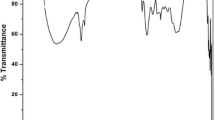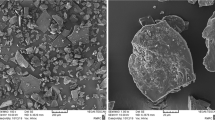Abstract
In the present study, the ability of Hibiscus rosa-sinensis leaf extract (HLE) to act as a natural coagulant for the water treatment was tested. Synthetic turbid solutions were prepared using kaolinite, and the efficiency of HLE was examined for low and high turbid solutions. HLE was very effective in high turbid solutions than in low turbid water and follows enmeshment mechanism of destabilization. An insignificant effect of alkalinity on the performance of HLE was observed. The addition of NaCl increased the dissolution of coagulation active species and enhanced the efficiency of HLE, significantly. Hydroxyl and carboxyl groups present in HLE were the major functional groups responsible for the bonding between coagulant and kaolinite. The efficiency of alum was very high compared to that of HLE in both turbid solutions. But the optimal dosages of HLE were lesser than that of alum. Thus, HLE can be used as a coagulant aid for the effective treatment of water.






Similar content being viewed by others
References
Abd El Latif, M., MohyEldin, M. S., & El Kady, M. F. (2005). Settling of high concentrations of clay suspended in water by nonionic polyacrylamide flocculants. Engineering Journal, 44, 325–338.
Ani, J. U., Nnaji, N. J., Okoye, C. O. B., & Onukwuli, O. D. (2012). The coagulation performance of okra mucilage in an industrial effluent by turbidimetry. International Journal of Chemical Sciences, 10, 1293–1308.
Aroke, U. O., El-Nafaty, U. A., & Osha, O. A. (2013). Properties and characterization of kaolin clay from Alkaleri, north-eastern Nigeria. International Journal of Emerging Technology and Advanced Engineering, 3, 387–392.
Awang, N. A., & Aziz, H. A. (2012). Hibiscus rosa-sinensis leaf extract as coagulant aid in leachate treatment. Applied Water Science, 2, 293–298.
Awang, N. A., Aziz, H. A., Bashir, M. J. K., & Umar, M. (2013). Comparative removal of suspended solids from landfill leachate by Hibiscus rosa-sinensis leaf extract and alum. Desalination Water Treat, 51, 2005–2013.
Bhuptawat, H., Folkard, G. K., & Chaudhari, S. (2007). Innovative physico-chemical treatment of wastewater incorporating Moringa oleifera seed coagulant. Journal of Hazardous Materials, 142, 477–482.
Diaz, A., Rincon, N., Escorihuela, A., Fernandez, N., Chacin, E., & Forster, C. F. (1999). A preliminary evaluation of turbidity removal by natural coagulants indigenous to Venezuela. Process Biochemistry, 35, 391–395.
Divya, M. J., Sowmia, C., Dhanya, K. P., & Joona, K. (2013). Screening of antioxidant., anticancer activity and phytochemicals in methanolic extract of Hibiscus rosa-sinensis leaf extract. Research Journal of Pharmaceutical, Biological and Chemical Sciences, 4, 1308–1316.
Essiett, U. A., & Iwok, E. S. (2014). Floral and Leaf Anatomy of Hibiscus Species. American Journal of Medical and Biological Research, 2, 101–117.
Fatombi, J. K., Lartiges, B., Aminou, T., Barres, O., & Caillet, C. (2013). A natural coagulant protein from copra, (Cocos nucifera), isolation, characterization, and potential for water purification. Separation and Purification Technology, 116, 35–40.
Gandhimathi, R., Jegan Durai, N., Nidheesh, P. V., Ramesh, S. T., & Kanmani, S. (2013). Use of combined coagulation-adsorption process as pretreatment of landfill leachate. Iranian Journal of Environmental Health Science and Engineering, 10, 24.
Gupta, P., Jain, P., & Jain, P. K. (2012). Isolation of natural acid base indicator from the flower sap of Hibiscus rosa sinensis. Journal of Chemical and Pharmaceutical Research, 4, 4957–4960.
IS 10500 (2012). Indian Standard, Drinking Water — Specification; Bureau of Indian standards, New Delhi.
Krishna Prasad, R. (2009). Color removal from distillery spent wash through coagulation using Moringa oleifera seeds, use of optimum response surface methodology. Journal of Hazardous Materials, 165, 804–811.
Kumar, A., & Singh, A. (2012). Review on Hibiscus rosa sinensis. International Journal of Research in Pharmaceutical and Biomedical Sciences, 3, 534–538.
Li, W., Liu, M., Wu, S. Z., & Xu, Y. (2015). An inexact optimization model associated with two robust programming approaches for water resources management. International Journal of Environmental Science and Technology, 12, 2401–2414.
Muthuraman, G., & Sasikala, S. (2014). Removal of turbidity from drinking water using natural coagulants. Journal of Industrial and Engineering Chemistry, 20, 1727–1731.
Ndabigengesere, A., & Narasiah, K. S. (1996). Influence of operating parameters on turbidity removal by coagulation with Moringa oleifera seeds. Environmental Technology, 17, 1103–1112.
Ndabigengesere, A., & Narasiah, K. S. (1998). Quality of water treated by coagulation using moringa oleifera seeds. Water Research, 32, 781–791.
Nevade Sidram, A., Lokapure, S. G., & Kalyane, N. V. (2011). Study on anti-solar activity of ethanolic extract of flower of Hibiscus rosa-sinensis. Linn Research Journal of Pharmacy and Technology, 4, 472–473.
Nidheesh, P. V., Gandhimathi, R., Ramesh, S. T., & Anantha Singh, T. S. (2011). Investigation of equilibrium and thermodynamic parameters of crystal violet adsorption onto bottom ash. Journal of International Environmental Application & Science, 6, 461–470.
Nidheesh, P. V., Gandhimathi, R., Ramesh, S. T., & Anantha Singh, T. S. (2012). Kinetic analysis of crystal violet adsorption on to bottom ash. Turkish Journal of Engineering and Environmental Sciences, 36, 249–262.
Okuda, T., Baes, A. U., Nishijima, W., & Okada, M. (1999). Improvement of extraction method of coagulation active components from Moringa oleifera seed. Water Research, 33, 3373–3378.
Oladoja, N. A., & Aliu, Y. D. (2009). Snail shell as coagulant aid in the alum precipitation of malachite green from aqua system. Journal of Hazardous Materials, 164, 1496–1502.
Panga, J. A. (2014). Plants of AMS Garden: A Garden in the Arabian Deserts of Dubai. Xlibris Corporation.
Patel, H., & Vashi, R. T. (2012). Removal of Congo Red dye from its aqueous solution using natural coagulants. Journal of Saudi Chemical Society, 16, 131–136.
Patel, R., Patel, A., Desai, A., & Nagee, A. (2012). Study of secondary metabolites and antioxidant properties of leaves, stem and root among Hibiscus rosa-sinensis cultivars. Asian Journal of Experimental Biological Sciences, 3, 719–725.
Prasad, M. P. (2014). In vitro phytochemical analysis and antioxidant studies of Hibiscus species. International Journal of Pure & Applied Bioscience, 2, 83–88.
Ruban, P., & Gajalakshmi, K. (2012). In vitro antibacterial activity of Hibiscus rosa-sinensis flower extract against human pathogens. Asian Pacific Journal of Tropical Biomedicine, 2, 399–403.
Saikia, B. J., & Parthasarathy, G. (2010). Fourier transform infrared spectroscopic characterization of kaolinite from Assam and Meghalaya, northeastern India. Journal of Modern Physics, 1, 206–210.
Salem, M. Z. M., Olivares-Pérez, J., & Salem, A. Z. M. (2014). Studies on biological activities and phytochemicals composition of Hibiscus species—a review. Life Science Journal, 11, 1–8.
Saritha, V., Swetha Chowdhary, K., & Harish Kumar, B. S. S. S. (2012). Evaluation of chitin as natural coagulant in water treatment. Journal of Advanced Laboratory Research in Biology, 3, 109–114.
Shak, K. P. Y., & Wu, T. Y. (2015). Optimized use of alum together with unmodified Cassia obtusifolia seed gum as a coagulant aid in treatment of palm oil mill effluent under natural pH of wastewater. Industrial Crops and Products, 76, 1169–1178.
Shilpa, B. S., Kavita, A., & Girish, P. (2012). Evaluation of cactus and hyacinth bean peels as natural coagulants. International Journal of Chemical and Environmental Engineering, 3, 187–191.
Subramonian, W., Wu, T. Y., & Chai, S.-P. (2015). An application of response surface methodology for optimizing coagulation process of raw industrial effluent using Cassia obtusifolia seed gum together with alum. Industrial Crops and Products, 70, 107–115.
Syafalni, Lim, H. K., Ismail, N., Abustan, I., Murshed, M. F., & Ahmad, A. (2012). Treatment of landfill leachate by using lateritic soil as a natural coagulant. Journal of Environmental Management, 112, 353–359.
Teh, C. Y., & Wu, T. Y. (2014). The potential use of natural coagulants and flocculants in the treatment of urban waters. Chemical Engineering Transactions, 39, 1603–1608.
Teh, C. Y., Wu, T. Y., & Juan, J. C. (2014). Optimization of agro-industrial wastewater treatment using unmodified rice starch as a natural coagulant. Industrial Crops and Products, 56, 17–26.
Teh, C. Y., Budiman, P. M., Shak, K. P. Y., & Wu, T. Y. (2016). Recent advancement of coagulation-flocculation and its application in wastewater treatment. Industrial & Engineering Chemistry Research, 55, 4363–4389.
Thakur, S. S., & Choubey, S. (2014). Use of Tannin based natural coagulants for water treatment: an alternative to inorganic chemicals. International Journal of Chem Tech Research, 6, 3628–3634.
Vaculíková, L., Plevová, E., Vallová, S., & Koutník, I. (2011). Characterization and differentiation of kaolinites from selected Czech deposits using infrared spectroscopy and differential thermal analysis. Acta Geodynamica et Geomaterialia, 8, 59–67.
Venu, C., Ramesh, S. T., Gandhimathi, R., & Nidheesh, P. V. (2016). Investigation on the working performance of partitionable space enhanced coagulation reactor. Separation Science and Technology, 51, 1220–1226.
Weber, W. J. (1972). Physicochemical processes for water quality control John Wiley and Sons., Inc USA
Wu, T. Y., Mohammad, A. W., Lim, S. L., Lim, P. N., & Hay, J. X. W. (2013). Recent advances in the reuse of wastewaters for promoting sustainable development. Wastewater Reuse Manage 47-103., DOI, 101007/978-94-007-4942-9_3
Zhang, J., Zhang, F., Luo, Y., & Yang, H. (2006). A preliminary study on cactus as coagulant in water treatment. Process Biochemistry, 41, 730–733.
Zhang, Z., Xia, S., Zhao, J., & Zhang, J. (2010). Characterization and flocculation mechanism of high efficiency microbial flocculant TJ-F1 from Proteus mirabilis. Coll Surf B Biointerfaces, 75, 247–251.
Author information
Authors and Affiliations
Corresponding author
Rights and permissions
About this article
Cite this article
Nidheesh, P.V., Thomas, P., Nair, K.A. et al. Potential Use of Hibiscus Rosa-Sinensis Leaf Extract for the Destabilization of Turbid Water. Water Air Soil Pollut 228, 51 (2017). https://doi.org/10.1007/s11270-016-3232-1
Received:
Accepted:
Published:
DOI: https://doi.org/10.1007/s11270-016-3232-1




